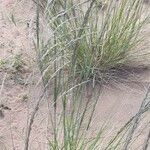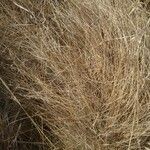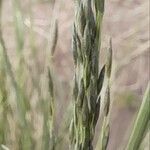Densely tufted perennial to 1200 mm high, erect, wiry; basal sheaths densely hairy for quite a way up from base, with long hairs in the deep furrows between prominent, squarish ridges formed by closely packed nerves; culms unbranched, not easily compressed, nodes glabrous. Leaf blade to 500 x to 3 mm, rolled or flat, appearing setaceous, long tapering to filiform apex. Inflorescence much branched, variable, open and spreading to contracted and dense with branches adpressed to main axis; lowest branches whorled or not whorled; pedicels smooth or with prickles distant from one another; spike-lets adpressed to branches. Spikelet 4-10 x 1.0-1.5 mm, linear to oblong; rachilla persistent or upper part often fragile, lemmas and/ or paleas breaking up from base upwards; glumes lanceolate, translucent, of variable length but longer than 1/3 the length of lemma above, apex acute, smooth or scaberulous at apex and along keels; lemma 1.4-2.6 mm long, lateral nerves indistinct, pale green to dark green to greyish; palea persistent, margins touching or overlapping for entire length or if not touching, very close especially at the apex; keels a thin narrow line or appearing as only folded; anthers 3, 0.6-1.2 mm long; caryopsis ellipsoid.
Wiry perennial, erect and densely tufted, up to 1.2 m high. Leaf blades up to 500 mm long, up to 3 mm wide. Plants variable, culms unbranched, not easily compressed, nodes glabrous; basal sheaths densely hairy for quite a way up from base, with long hairs in deep furrows between prominent, squarish ridges formed by closely packed nerves; leaf blades rolled orflat, appearing setaceous, with long tapering, filiform tips. Spikelets 4-10 mm long, 1.0-1.5 mm wide. Inflorescence much-branched, variable, being open and spreading, or contracted with branches appressed to main axis, lowest branches whorled or not whorled, pedicels smooth or with prickles distant from one another, spikelets appressed to branches; spikelets linear to oblong, rhachilla persistent or upper part often fragile, lemmas and/or paleas breaking up from base upwards; glumes translucent, of variable length but longer than a third the length of lemmas above in intact spikelet, smooth or scaberulous at apex and along keels; lemma pale green to dark green to greyish; palea margins meeting or overlapping for entire length, keels a thin narrow line or palea apparently only folded; anthers 3.0,6-1.0 mm long. Caryopsis ellipsoid.
Perennial; up to 1.2 m high; erect and densely tufted; wiry; variable; Culms unbranched; not easily compressed; nodes glabrous. Leaf blades up to 500 x 3 mm; basal sheaths densely hairy with long hairs in deep furrows between prominent; squarish ridges formed by closely packed nerves; with blades rolled or flat; appearing setaceous; with long tapering; filiform apices. Flowers: panicle much branched; variable; open and spreading; or contracted with branches appressed to main axis; lowest branches whorled or not whorled; pedicels smooth or with prickles distant from one another; spikelets appressed to branches; rachilla persistent or upper part often fragile; lemmas and/or paleae breaking up from base upwards; spikelets 4-10 x 1.0-1.5 mm; linear to oblong; glumes translucent; of variable length but > 1/3 length of lemmas above in intact spikelet; smooth or scaberulous at apex and along keels; lower glume lanceolate in side view; apex acute; lemmas pale green to dark green to greyish; palea margins meeting or overlapping for entire length; keels a thin; narrow line or palea apparently only folded; anthers 3; 0.6-1.0 mm long; caryopsis ellipsoid.
Tussock-forming perennials; cataphylls and basal leaf sheaths coriaceous, sericeous between nerves, purple or becoming straw-coloured. Culms sometimes ascending, 30–120 cm high. Leaves sometimes pilose with tubercle-based hairs; sheaths usually overlapping; ligule 0.3–1 mm long; blade usually filiform-convolute, often curled, to 30 cm long, c. 3 mm wide with capillary apex. Panicles dense or open, 6–30 cm long, to 20 cm wide; rachis and branches sometimes glandular-striate; branches naked for up to 4.8 cm. Spikelets sessile, linear, 4–10 mm long, 1–1.5 mm wide; rachilla weakly flexuose, scaberulous; florets 4–13, loosely overlapping, with apical floret reduced. Glumes: lower glume linear or lanceolate, 1–2 mm long; upper glume ovate to lanceolate, 1.5–3 mm long. Lemma ovate-elliptic, 1.8–2.8 mm long, obtuse, membranous, 3-nerved. Palea: body spathulate or oblong, finally dividing along midline; flaps almost as wide as body. Stamens 3; anthers 0.8–1.3 mm long. Grain quadrangular, ovoid-ellipsoid, 0.5–1.5 mm long, sometimes concave or grooved, occasionally with minute stipe.
Erect, densely tufted, wiry perennial, up to 1.2 m high; basal sheaths densely hairy with long hairs in deep furrows between prominent, squarish ridges formed by closely packed nerves. Leaf blade up to 500 x 3 mm, flat or rolled, appearing setaceous, apex long tapering, filiform; ligule a fringe of hairs. Inflorescence a much-branched panicle, variable, open and spreading, or contracted with branches appressed to main axis, lowest branches whorled or not whorled; pedicels smooth or with prickles distant from one another; spikelets appressed to branches. Spikelets 4-10 x 1.0-1.5 mm, laterally compressed; rachilla persistent or upper part often fragile, lemmas and/or paleas breaking up from base upwards; glumes translucent, shorter than spikelet, 1-nerved. Florets many; lemma entire, 3-nerved, pale green to dark green to greyish; palea margins meeting or overlapping for entire length, keels a thin narrow line or palea apparently only folded; anthers 3, 0.6-1.0 mm long. Flowering time Aug.-June. Caryopsis ellipsoid.
Perennial. Culms densely tufted, erect, 80–120 cm tall, 5–6-noded. Leaf sheaths scabrous with retrorse hairs at lower part, glabrous upward, shorter than internodes, long pilose along the summit; leaf blades elongate, involute, attenuate to a fine point, arcuate spreading, scabrous, (5–)10–40 cm × 1–2.5(–3) mm. Panicles open, 12–35 × 6–9 cm; branches solitary or in pairs, ascending, naked at base, at least the lower densely pilose in axils. Spikelets gray-green, (4–)6–11 × 1.5–2 mm, 5–16-flowered. Glumes lanceolate, apex acuminate, 1-veined, lower glume 1.2–1.5 mm, upper glume 1.8–2.5 mm. Lemmas broadly oblong, apex acute or obtuse, veins prominent, lower lemma 2–2.5 mm. Palea subequal to lemma, 2-keeled, persistent or tardily deciduous. Stamens 3; anthers ca. 1.2 mm. Caryopsis ellipsoid to obovoid, dorsally compressed, adaxial surface with a shallow, broad groove or ungrooved, smooth, mostly translucent, light brown, 1–1.7 mm. Fl. and fr. Apr–Sep. 2n = 20, 42, 63, 80.
Densely tufted perennial; basal leaf-sheaths strongly striate with the nerves forming prominent ridges, often hard and yellowish, appressed silky hairy below; culms 30–120 cm. high, slender or robust, usually erect.. Leaf-blades narrow, up to ± 30 cm. long, 3 mm. wide, usually rolled or filiform.. Panicle very variable, loose and spreading to narrow and contracted, 6–30 cm. long, the lowest branches often whorled and hairy in the axils.. Spikelets 4–13-flowered, linear, 4–10 mm. long, 1–1.5 mm. wide, grey-green, breaking up from the base, the rhachilla persistent below but fragile above; lower glume lanceolate, 1–1.8 mm. long, 1/3-3/4 as long as the lowest floret; upper glume narrowly ovate, 1.5–2.2 mm. long; lemmas ovate-elliptic, 1.8–2.6 mm. long, appressed to the rhachilla; palea smooth or minutely scaberulous on the keels, persistent; anthers 3, 0.8–1.1 mm. long.. Caryopsis ellipsoid, 0.7 mm. long.
Spikelets 4–10 × 1–1.5 mm, linear to narrowly oblong, laterally compressed, 4–13-flowered, the lemmas disarticulating from below upwards, the rhachilla persistent, sometimes fragile above; glumes unequal, keeled, glabrous, acute at the apex, the inferior 1–1.8 mm long, reaching to between 2/3 and 4/5 the way along the adjacent lemma, narrowly lanceolate in profile, the superior 1.5–2.5 mm long, reaching to between 1/2 and 3/4 the way along the adjacent lemma, lanceolate in profile; lemmas 1.4–2.6 mm long, keeled, narrowly ovate-elliptic in profile, membranous with indistinct lateral nerves, appressed to the rhachilla, those in opposite rows not overlapping, the rhachilla visible between them, greyish-green, minutely scaberulous, subacute at the apex; palea persistent, glabrous on the flanks, the keels slender, wingless, smooth and glabrous or scaberulous; anthers 3, 0.8–1.1 mm long.
Erect, tufted perennial 6–18 dm; sheaths keeled and ± hispidulous basally; lvs firm, involute, narrow, arcuate-ascending, tapering to a fine point; infl 2–3.5 dm, pilose in the main axils, elongate and open but scarcely diffuse, the pedicels short and ± appressed to the branchlets; spikelets leaden-gray, 5–9 mm, 5–9(–11)-fld, the lemmas individually deciduous or more persistent and the rachilla fragmenting; first glume 1.5–2(2.5) mm, the second 2–2.8 mm; lemmas 2–3 mm, evidently 3-veined; 2n=20, 40, 60. Native of S. Afr., cult. for forage or ornament and escaped at scattered stations as far n. as N.J. and Pa. (where becoming common).
Densely caespitose perennial without rhizomes or stolons; culms up to 120 cm tall, slender or stout, firm or spongy, usually erect, sometimes ascending, usually unbranched, rarely branched, glabrous at the nodes, the internodes glabrous or pilose, eglandular; basal leaf sheaths silky-pilose below, coriaceous and hard, the nerves forming close, prominent ridges, terete, eglandular, persistent; ligule a line of hairs; leaf laminas 10–30 cm × 1–3(10) mm, linear to broadly linear, flat or involute, sometimes filiform, straight or flexuous, glabrous to pilose, eglandular.
Variable, densely tufted perennial, up to 1 m tall. Basal sheaths hard, nerves forming prominent ridges, densely hairy between nerves. Leaves linear, with long, tapering, filiform tips; ligule a fringe of hairs. Inflorescence a much-branched open or contracted panicle, lowermost branches whorled or not. Spikelets 4-10 x 1-1.5 mm, many-flowered, dark greyish green, awnless, rhachilla persistent or fragile above only; glumes unequal, shorter than spikelet; anthers 0.6-1 mm long.
A grass. A densely tufted plant. It keeps growing from year to year. It grows 60-100 cm high. There are many leaves and they are very narrow They have a fine tip. The flowering shoots can be 30 cm long. There are many flowering spikes lying close to the branch. They are dark grey-green. They are 5-6 mm long.
Panicle 6–30 cm long, ovate and loose and spreading to narrow and contracted, the spikelets evenly distributed on pedicels 0.5–4 mm long, the primary branches in whorls below or not, terminating in a fertile spikelet, glabrous or pilose in the axils, eglandular.
Perennial to 1 m. Leaves linear, often rolled and filiform, basal sheaths densely hairy. Spikelets in open, much-branched panicles, 4-10 x 1.0-1.5 mm, dark green.
Caryopsis 0.7–1 mm long, elliptic.



